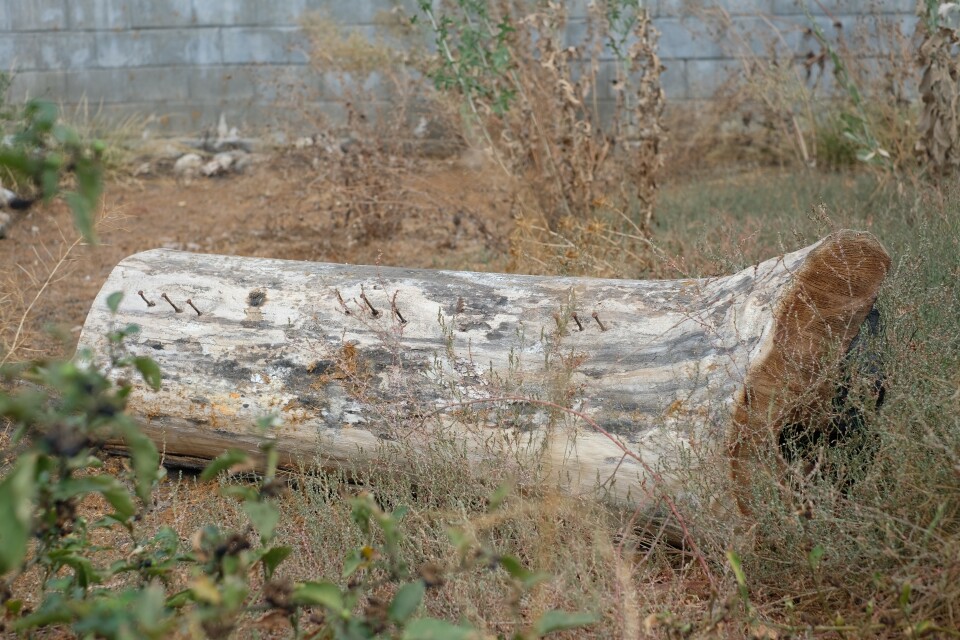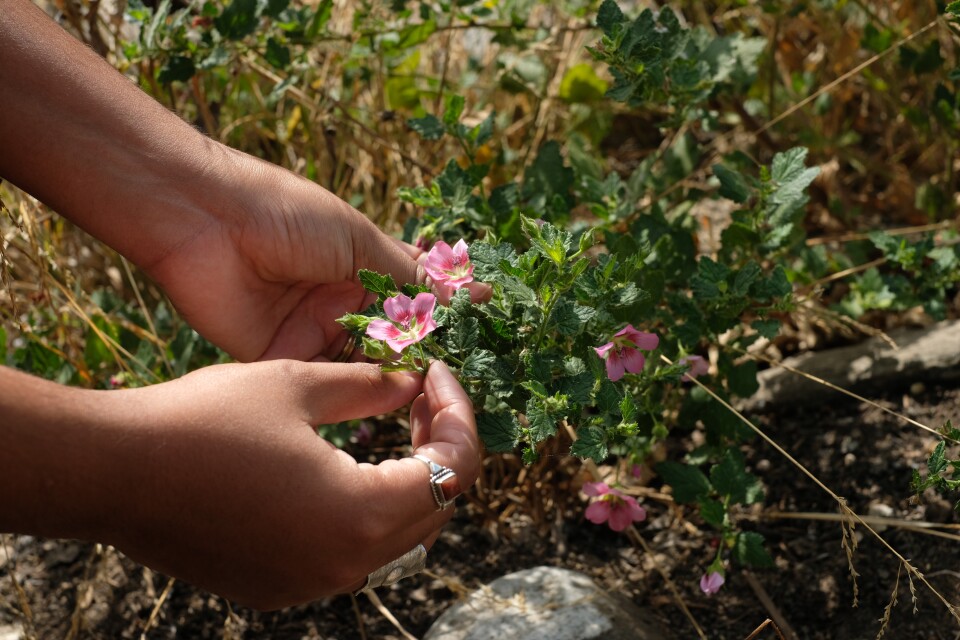Truth matters. Community matters. Your support makes both possible. LAist is one of the few places where news remains independent and free from political and corporate influence. Stand up for truth and for LAist. Make your tax-deductible donation now.
Mona Patterson walks across the dirt lot that once was her family’s home in west Altadena.
“It's just nice seeing some of the plants that we planted are growing back,” she says, leaning down to touch the leaves of a small lemon tree. “This is our lemon tree that we had — it was here when we moved here, and it was one of our favorite things.”
The tree — once a source for homemade lemon meringue pies and lemon bars — burned in the Eaton Fire. But to Patterson’s surprise, it’s sprouting again.
“And it's like brand new in a baby size, so that's really cute,” she says. “So hopefully we can keep this when we rebuild.”

The 22-year-old grew up here and has deep roots in the community. She, her twin sister and parents lived right around the corner from her grandparents, who bought their home in 1973 when they moved from Louisiana.
“Family living close by was one of the main reasons my parents decided to live here,” Patterson says.
The Eaton Fire took both family homes.
Tell your tree story
To tell your tree story, keep an eye on Mona Patterson’s website. She plans to continue gathering the tree stories of her neighbors.
Also, watch for an illustrated remembrance of Altadena from LAist's own David Rodriguez.
And as the rebuilding begins for her family and others, Patterson is collecting the stories of Altadena’s trees. For the seven months, she’s interviewed neighbors about their relationships with trees that survived — or that died in the fire or the subsequent debris removal.
Patterson recently graduated from Chapman University with a degree in journalism and environmental science. Telling these stories from her community was fitting.
“With these tree stories, I was like, ‘Oh, I bet my neighbors have something similar where they have a tree that was either part of their children's childhood or their reason why they wanted to move here,” she says.
In a way, the trees were an extension of family, like neighbors who ensured you were well fed and looked after. ... To return and no longer recognize your street, to miss the faint aroma of orange blossoms ... or to no longer hear the rhythmic thwack of branches in the evening breeze — this is a displacement that unsettles your very sense of belonging.
One neighbor described a camphor tree whose boughs supported his children’s treehouse. Another, a fig tree that was the backdrop to a marriage ceremony. An oak tree, likely more than a hundred years old, also survived and now is a reminder of hope for one neighbor. Another group of trees was a morning rest stop for squawking parrots. And countless citrus trees gifted fruit to anyone walking by, reminding them to slow down, maybe talk to a neighbor for a while.
“It was just so beautiful and I was just like, wow ... everyone has a tree story,” Patterson says.
As for Patterson’s? She describes a mulberry tree that was once in the center of their yard.

The tree shaded everyone who entered their home and was a fixture of Patterson’s childhood.
“It wasn't too crazy big, so we put little steps on it, and we eventually put tire swings,” Patterson says. “As we were growing up, we would climb along its branches, swing on the branches.”
Patterson and her twin sister would build little fairy houses, nestling them in the tree's roots.
In their deep roots and sprawling branches, one could see the essence of Altadena — a place rich in history, diversity and a quiet resilience that stands the test of time.
“And then after the fire, one of the main things when we came here was like, ‘Oh, is our tree gone? How is our tree?” Patterson says. “And it was burned.”
The family asked the Army Corps to leave the stump and a log from the trunk that still has nails sticking out of it. That’s where, before the fire, there were wooden planks that Patterson and her sister used for climbing.

The family plans to turn the log into a side table, or maybe an art piece, to honor the mulberry.
“It just really connected us to our home, to our yard and to nature in a different way,” Patterson says.
Although Patterson’s former home is still an empty dirt lot, every day, life seems to be returning.
Blueberry bushes have popped up. California natives that Patterson’s mother planted are growing back, once again enticing the hummingbirds and bees.
“It's definitely healing,” Patterson says, stopping to rub the lemon tree’s leaves and release the citrusy scent. It’s a comfort — and encouragement — she says, “seeing the land go through the same type of loss that you go through and how resilient it is.”

Altadena tree stories
Editor's note: These are some of the stories Patterson collected from her neighbors, lightly edited for length and style.
Jeff, Palm Street

When I was a boy, the very first tree I learned to climb was the big camphor tree in my grandma’s front yard. And when I was a grown man shopping for a house to start a family in with my wife, we found a house with a giant camphor tree, just like my grandma’s camphor tree from my youth.
It was one of the driving reasons that pushed us to choose that house to buy and start a family in. During the COVID lockdowns, we couldn’t leave the house much, so I used the time to build a tree house in that tree. Supposedly it was for my kids, but secretly it was the dream tree house that I always had wanted ever since my boyhood.
My heart is broken. It feels like a piece of our world has been amputated. My tree house is ash, and the giant camphor tree I loved so much is dead.
Suzanne, West Altadena Drive

Hercules came from Roger's Gardens down in Newport Beach. He was in a 5-gallon pot, cost $20 and looked prehistoric with a stout, textured trunk and thick, sharp, angled leaves. Hercules did not like being in the 5-gallon pot, and he made his unhappiness very clear by pushing giant roots out through the holes in the bottom of the pot.
Upon further research, I learned that Hercules is a man-made hybrid, aloe barberae crossed with aloe dichotoma. The hybridizers thought this would create a smaller more compact aloe tree, but instead it created a monster that grows faster and larger than any other aloe tree.
I wanted to take it out, but my partner wouldn't have it. He loved Hercules already and was thrilled by the prospects of having a gigantic Frankenstein aloe tree. So Hercules stayed and made his presence known.
Hercules was one of the first things I thought about when I realized our house might be gone. I can't imagine the yard without him.
On the morning of Jan. 8, Hercules was still standing — strong and tall, like a sentinel — with no visible damage. Now about 25 feet high, he provides shelter for house finches and the perfect lookout tower for mockingbirds.
He is resilient and strong, and when I feel like giving up, he reminds me to stand tall and keep moving forward.
Lily, Porter Avenue
The cedar trees were an integral part of the house for my family. The trees were so tall and their long branches so sprawling that looking out the second-story windows, where my bedroom was as a teen, felt like peering out of a tree house.
On windy nights their branches tickled the house, and several times one broke off, falling with a terrifying, thunderous crack.
The cedar trees hugged the house, seemed to wrap their arms around it.
They have no house to hug or protect anymore — instead it feels like they are the house now.
When we have gone to the property, we inevitably find ourselves sitting below their branches, enjoying the small sliver of home they hold. The fact that they still stand feels deeply reassuring to all of us and imagining them still there standing sentinel for many years to come is a comforting image. Our family won't be there anymore, but they will, and they will hold our memories and tie our legacy to that land.
Lauren, Crest Drive

The trees meant a lot to my family. They were home to so many critters, birds, squirrels, even the occasional bobcat. They provided my family shade in the hot L.A. summers.
Growing up, my brother and I spent many days climbing in them and swinging on the swings my dad built us.
In later years, I would set up my hammock using the trees and read books under them.
The trees were part of what made our house a home.
While our home did not survive, our beautiful oak trees did. We estimate the trees are over 100 years old and were there even before our house was built. [Their survival] gives us hope and strength for the unknown future.












